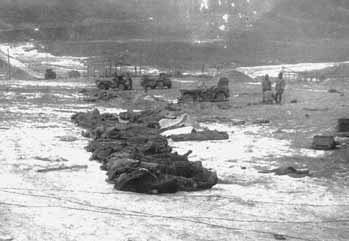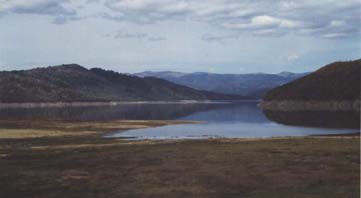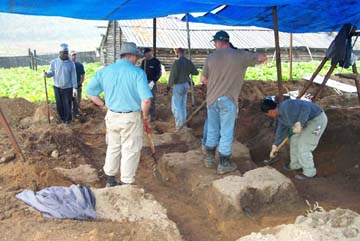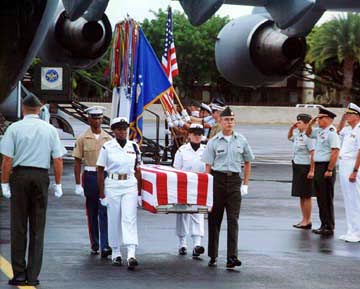CHANGJIN JOURNAL 11.27.01
The Changjin Journal is designed to
disseminate and solicit information on the Chosin campaign. Comments and brief essays are
invited. Subject matter will be limited to history of the Chosin campaign, as well as past or
present interpretation of that history. See End Notes for distribution and other notices.
Colonel George A. Rasula, USA‐Ret, Chosin Historian Byron Sims, Contributing
Editor
THIS ANNIVERSARY ISSUE establishes a link between history
fifty‐one years ago and recent efforts by the Recovery Team from Hawaii in the area of
the Chosin Reservoir, returning with remains of U.S. servicemen.
FIFTY‐ONE YEARS AGO During the Chosin campaign east of the reservoir, the main battle was
fought by RCT 31 units in a perimeter located on the south side of the inlet formed by the
Pungnyuri‐gang River that flows into the reservoir from the northeast. On 27‐28
November the 1st Battalion, 32 Infantry (1/32) had been located about three kilometers north of
the inlet. It withdrew in the early morning hours of 29 November to join the 3d Battalion, 31
Infantry (3/31) in the perimeter. Here the battle continued into the morning of 1 December. The
breakout began at noon and became a moving battle as the enemy followed on the flank of the
breakout column until it faced the main Chinese blocking positions on Hill 1221. The column was
eventually destroyed a few kilometers south of the hill. The 31st Regimental Combat Team (RCT
31), which consisted of only two infantry battalions and one artillery battalion, had faced the
assaults of two CCF divisions backed up by one regiment of a third division, all part of the
Chinese commander's main effort to capture Hagaru‐ri before the arrival of the
Marines from Yudam‐ni. 
31ST INF DEAD AT INLET 1950 Bodies of soldiers from 3d Battalion, 31
Infantry, killed inside the perimeter. Most are from Company L and Battalion
Headquarters Company. Interviews of survivors led to the CILHI recovery mission in this
area. ‐Photo courtesy Bill Donovan, Weapons Platoon sergeant, L 3/31.
Although a large number of the bodies remained in and around the
forward perimeter, many soldiers were killed along the road and railroad as the column moved
south; many also fell on the north and south slopes of Hill 1221. Hundreds of dead remained
in and next to the column of trucks, a destroyed convoy that eventually extended over four
kilometers. To this day, there has never been an accurate report of killed, missing and
wounded in units of RCT 31. The official army history, Ebb and Flow published in 1990, lists
70 killed in action, 185 wounded in action and 2,505 as missing in action for the 7th
Infantry Division, with no breakdown for subordinate units. The most accurate estimate is
that "between 1,000 and 1,500 soldiers of RCT 31 were killed or missing" during
the Chosin action between 27 November and 2 December 1950. Among the senior officers lost
were Col. Allan D. MacLean, RCT commander; Lt. Col. Don C. Faith, who assumed command of RCT
31 after loss of MacLean; and two majors from the 3d Battalion, 31 Infantry.

On 14 November 1950 when the 7th Marines arrived at the south end of
the reservoir, the lake looked like this. By 24 November when the 5th
Marines moved up the east side of the reservoir the ice was just
beginning to form, and by 29 November when the 1/32 Infantry was
withdrawing
to the 3/31 perimeter south of this Inlet, Colonel
MacLean and others walked
across the ice. ‐Photo courtesy CILHI,
September 2001
CILHI ‐ THE U.S. ARMY CENTRAL IDENTIFICATION LABORATORY‐HAWAII
Recovery and identification of American human remains from battle sites in North Korea is a
sophisticated and exhaustive process that has been ongoing since 1996. Now, for the first
time since the bitter fighting in late 1950, U.S. search teams are probing the once stark
and forbidding terrain of the Chosin Reservoir for the remains of those classified for 50
years as either KIA or MIA–body not recovered. One assumes they were members of RCT
31. Once recovered from their burial location, the remains are taken to the U.S. Army
Central Identification Laboratory‐Hawaii (CILHI), commanded by Col. David J. Pagano.
The lab's recovery teams conduct operations in the Pacific for the fallen of World War
II, the Korean War and the Vietnam War. At the lab, remains are scrutinized through the use
of anthropological, odontological and other sophisticated scientific techniques. The
findings are then entered into a Computer Assisted Post Mortem Identification system which
contains dental records of servicemen whose remains are listed as unrecovered. The CAPMI
database is searched for a possible match. This data and other information eventually lead
to a recommendation for identification and an eventual return of the remains to respective
families for final disposition. The process is painstaking; the effort is daunting. More
than 8,000 Americans are still listed as missing in Korea.
HISTORY
UNCOVERED

This photograph of Work Site 2 needs no explanation. One must have
been there to understand the methods these trained soldiers use to
unearth
remains of soldiers past who gave all to their country. Photo
courtesy
CILHI, 2001.
During September‐October of this
year messages were being passed through the internet with information that a recovery team
was operating in the area of the Chosin Reservoir. One of the first messages included a
scenic photo of the reservoir. This excited survivors of Chosin because they had been
waiting more than fifty years for this recovery to happen, to know that their buddies were
finally coming home. However, they knew it would be a major project because of the many
hundreds of soldiers who were left on that frozen ground in December 1950. Although knowing
where many of them had fallen, survivors of Chosin were anxious to learn where they had been
buried, by whom, and about the eventual identification of remains when they finally return
and are processed in Hawaii. It's been a long wait, sadly too long for the ranks of
survivors who have since passed on.
REMAINS OF U.S. SERVICEMEN RECOVERED
IN NORTH KOREA
News Release from the Department of Defense, November 9,
2001. "Remains believed to be those of eight American soldiers, missing in action from
the Korean War, will be repatriated in formal ceremonies Saturday, Korea time. This
repatriation marks the end of this year's operations. "The remains will be flown
on a U.S. Air Force aircraft from Pyongyang, North Korea, under escort of a uniformed U.S.
honor guard to Yokota Air Base, Japan, where a United Nations Command repatriation ceremony
will be held. "Operating near the Chosin Reservoir in North Korea, a joint team
recovered five remains believed to be those of U.S. Army soldiers from the 7th Infantry
Division who fought against Chinese forces Nov.‐Dec. 1950. Approximately 1,000 MIAs
are estimated to have been lost in battles of the Chosin campaign. "Additionally, a
second team recovered three sets of remains in Unsan and Kujang counties and along the Chong
Chon River, about 60 miles north of Pyongyang. The area was the site of battles between
Communist forces and the U.S. Army's 1st Cavalry Division, and 2nd and 25th Infantry
Divisions in November 1950. The Defense Department's POW/Missing Personnel Office
negotiated an agreement with the North Koreans last year that led to the scheduling of this
year's operations. "The 28‐person U.S. teams are composed primarily of
specialists from the Army's Central Identification Laboratory Hawaii (CILHI).
"This year's schedule of operations in North Korea was the largest since they
began five years ago, with 10 individual operations conducted near the Chosin Reservoir, as
well as in the Unsan, Kujang and Kaechon City areas. "Twenty‐seven individual
joint operations have been conducted since 1996 in North Korea, recovering 152 sets of
remains believed to be those of U.S. soldiers. Ten have been positively identified and
returned to their families for burial with full military honors. Another 12 are in the final
stages of the forensic identification process."

Bringing them home with honors. ‐Photo
courtesy CILHI, 2001
SUCCESSFUL RECOVERY MISSION
CILHI NEWS RELEASE Ginger Couden, Public
Affairs Officer U.S. Army Central Identification Laboratory, Hawaii
"Capt. Eric W. Frensley and Sgt. First Class Andrew Garate led the first ever U.S. Army
Central Identification Laboratory, Hawaii recovery team into the Chosin Reservoir, North
Korea area. The recovery occurred during the 4th Joint Recovery Operation of 2001 from Sept.
1 to Oct. 2. The 12‐member team was made up of servicemen from all services of the U.
S. Armed Forces. The Chosin team conducted operations involving three different sites, all
on the east side of the reservoir. These sites were all within the 31st Regimental Combat
Team's perimeter just below the Pungnyuri Inlet. Frensley lead a second team to the
Chosin area on the 5th and final Joint Recovery Operation of 2001 into North Korea from Oct.
20 to Nov. 9. The team sergeant for this mission was Sgt. First Class Kenton Gallion. The
team conducted operations involving five different sites on the east side of the reservoir.
The first site was in the Pungnyuri Inlet and the other four were on Hill 1221. In total,
CILHI recovered what is believed to be 19 missing U. S. servicemen from the Chosin Reservoir
area in the last two joint recovery operations of 2001. "It was a good opportunity for
the United States to recover some of those who gave their life relentlessly in the defense
of freedom," said Capt. Frensley. "I was honored to lead the first recovery team
to the Chosin Reservoir area."
END
NOTES Soldiers of Changjin have been waiting for fifty‐one years for
recovery to become a reality. During all these years it has been but a dream interrupted by
memories of buddies lost. The first photo in this essay taken in 1950 shows a few dozen
bodies of soldiers from the 3d Battalion, 31st Infantry (most believed to be from battalion
headquarters company and I and L companies). The recovery work site in the third photo is
very close to the location of the bodies shown in the 1950 photo may have contained their
remains. The specific recovery location reinforces the value of having survivors of the
battle interviewed at reunions as they have been for the past few years. Veterans of the
battle, now in their seventies and eighties, continue to look forward to visiting battle
sites at the Changjin Reservoir, still known to them as The Chosin.
|



